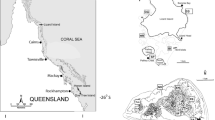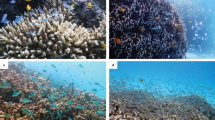Abstract
Data on early survivorship of newly settled reef fish were collected by monitoring individuals which recruited to 30 small lagoonal patch reefs over three summers. Preliminary survivorship curves spanning the first 45 days after settlement were derived for 17 species. Most species showed greatest rates of mortality in the first 1–2 weeks in the reef environment however there were substantial differences among species in the extent and the temporal pattern of this. In six species, 75% of individuals survived the 45 days, while in 5 others, 20% or fewer survived that long. In eight species, mortality was negligible after the first 14 days. In the other 9, significant mortality occurred in subsequent weeks. Patterns of survivorship did not appear to differ substantially among years in five of the six species for which data were adequate. In particular, survivorship did not appear to be different among years even when levels of recruitment varied greatly.
Similar content being viewed by others
References
Aldenhoven JM (1986) Local variation in mortality rates and life-expectancy estimates for the coral reef fish Centropyge bicolor (Pisces: Pomacanthidae). Mar Biol 92:237–244
Allen GR (1975) Damselfishes of the South Seas. TFH, Neptune City, NJ
Doherty PJ (1983a) Coral reef fishes: recruitment-limited assemblages? Proc 4th Int Coral Reef Symp 4:465–470
Doherty PJ (1983 b) Diel, lunar and seasonal rhythms in the reproduction of the tropical damselfishes: Pomacentrus flavicauda and P. wardi. Mar Biol 75:215–224
Doherty PJ (1983c) Tropical territorial damselfishes: is density limited by aggression or recruitment? Ecology 64:176–190
Doherty PJ, Sale PF (1986) Predation on juvenile coral reef fishes: an exclusion experiment. Coral Reefs 4:225–234
Eckert GJ (1984) Annual and spatial variation in recruitment of labroid fishes among 7 reefs in the Capricorn/Bunker Group, Great Barrier Reef. Mar Biol 78:123–127
Eckert GJ (1987) Estimates of adult and juvenile mortality for labrid fishes at One Tree Reef, Great Barrier Reef. Mar Biol 95:167–171
Luckhurst BE, Luckhurst K (1977) Recruitment patterns of coral reef fishes on the fringing reef of Curacao, Netherlands Antilles. Can J Zool 55:681–689
Molles MC (1978) Fish species diversity on model and natural reef patches: experimental insular biogeography. Ecol Monogr 48:289–305
Sale PF (1980) The ecology of fishes on coral reefs. Oceanogr Mar Biol Annu Rev 18:367–421
Sale PF (1985) Patterns of recruitment in coral reef fishes. Proc 5th Int Coral Reef Symp 5:391–396
Sale PF, Douglas WA (1984) Temporal variability in the community structure of fish on coral patch reefs and the relation of community structure to reef structure. Ecology 65:409–422
Sale PF, Steel WJ (1986) Random placement and the distribution of fishes among coral patch reefs. Mar Ecol Prog Ser 28:165–174
Sale PF, Doherty PJ, Eckert GJ, Douglas WA, Ferrell DJ (1984) Large-scale spatial and temporal variation in recruitment to fish populations on coral reefs. Oecologia 65:191–198
Sale PF, Eckert GJ, Ferrell DJ, Fowler AJ, Jones TA, Mapstone BA, Steel WJ (1986) Aspects of the demography of seven species of coral reef fishes, with recommandations for their management. Unpublished report to the Great Barrier Reef Marine Park Authority
Shulman MJ, Ogden JC, Ebersole JP, McFarland WN, Miller SL, Wolf NG (1983) Priority effects in the recruitment of juvenile coral reef fishes. Ecology 64:1508–1513
Smith CL (1978) Coral reef fish communities: a compromise view. Environ Biol Fish 3:109–128
Smith CL, Tyler JC (1975) Succession and stability in fish communities on dome-shaped patch reefs in the West Indies. Am Mus Novit 2572:1–18
Sweatman HPA (1983) Influence of conspecifics on choice of settlement sites by larvae of two pomacentrid fishes (Dascyllus aruanus and D. reticulatus). Mar Biol 75:225–230
Talbot FH, Russell BC, Anderson GRV (1978) Coral reef fish communities: unstable high-diversity systems? Ecol Monogr 49:425–440
Thresher RE (1984) Reproduction in reef fishes. TFH, Neptune City, NJ
Victor BC (1983 a) Recruitment and population dynamics of a coral reef fish. Science 219:419–420
Victor BC (1983 b) Settlement and larval metamorphosis produce distinct marks on the otoliths of the Slippery Dick, Halichoeres bivittatus. In: Reaka ML (ed) The ecology of deep and shallow coral reefs. Office of Undersea Research, US Department of Commerce, Washington, DC, pp 47–52
Victor BC (1986) Larval settlement and juvenile mortality in a recruit-limited coral reef fish population. Ecol Monogr 56:145–160
Author information
Authors and Affiliations
Rights and permissions
About this article
Cite this article
Sale, P.F., Ferrell, D.J. Early survivorship of juvenile coral reef fishes. Coral Reefs 7, 117–124 (1988). https://doi.org/10.1007/BF00300971
Accepted:
Issue Date:
DOI: https://doi.org/10.1007/BF00300971




